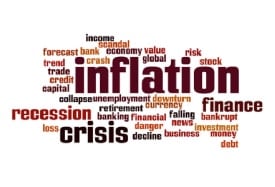Long before the “New Normal” propelled U.S. national debt at warp speed to $28 trillion (and counting) via COVID-19 corrective measures, inflation was a major topic of concern.
The more Treasury securities the Federal Reserve buys from the government’s reserve, the more the process hinges on the perception that Treasuries are stable.
After the 2008 financial “crisis” that resulted in a “bailout” to banks on the backs of taxpayers, the U.S. government saw an opportunity to strengthen its Treasury position and require all banks to always hold some quantity of them as a protection against another market collapse.

Treasuries are also spread abroad with the dollar’s status as the world’s reserve currency, resulting in 60% of foreign bank reserves being held in dollars with foreign investors owning about half of the U.S. debt.
Whether the national debt is the thing that changes the world’s mind about the dollar or some other factor, once it loses its position, the U.S. will have to face the difficult task of servicing the interest it already has, in addition to more borrowing.
Many economists have the idea that the Federal Reserve will always be able to prevent a mass sell-off by Treasury-holders who finally get “fed” up with the ongoing dollar devaluation.
The resulting phase of uncontrollable inflation could make past cautionary examples like Germany in the 1920s, Yugoslavia in the 1990s, and Zimbabwe in the 2000s seem like a precursor to what could take place for the U.S. dollar.
All this debt, when compounded with individual household debt, creates a perfect storm for inflation, a topic recently addressed in a White House article titled “Pandemic Prices: Assessing Inflation in the Months and Years Ahead.”
In the article, historic examples of short bursts of inflation from periods of pandemics or large-scale reallocations of economic resources, such as in 1918 — driven by the Spanish Flu and demobilization from World War I — are cited.
The article goes on to state that in the next several months, there is an expectation for measured inflation to increase somewhat, primarily due to base effects, supply chain disruptions, and pent-up demand, especially for services.
The explanation of base effects is stated as an initial month of a growth rate that is unusually low or high that distorts the understanding of how underlying, near-term trend inflation is behaving currently.
The White House article then states the second potential source of inflation as increases in the cost of production. When the cost of materials needed to produce a good or service rises for a business, the consumer sees higher prices.
Supply chain disruption is an obvious and unavoidable outcome of forcibly closing businesses and ensures that material prices will escalate.
The article acknowledges some supply chain disruptions due to the pandemic but ignores the crucial point of origin for these factors in the context of lockdowns.
Interestingly, the article also brings up the recent backlog in the Suez Canal in what seems to be an attempt to help divert attention even more from the real culprit of the more impactful disruptions.
The third cause the article presents is pent-up demand for services such as hotels, sit-down restaurants, and air travel that have seen prices drop during the lockdowns. The idea is presented that as more people get vaccinated throughout the year, demand for these and other high-touch services could surge and temporarily outstrip supply.
The article elaborates by stating that savings many households have accumulated during the pandemic, as well as relief payments from the fiscal responses last year and this year, may have created a high demand to eat out in full-service restaurants again later this year, but fewer dining options than were open pre-pandemic may prompt restaurants that are still open to raise their prices.
The writers of the article either fail to see the irony of this statement or seem content conveying the message that price gauging inflation is resulting from government-mandated shutdowns to “non-essential” businesses, and, when mixed with stimulus money that added trillions to the national debt, more inflation will be the outcome.
Concluding with a long-term outlook, the article presents a key determinant of lasting price pressures as inflation expectations. This notion hinges on the Federal Reserve’s 2-percent inflation target that, when accurate, may cause businesses to be less likely to adjust prices and wages but, when deviated from, may raise prices, causing central banks to raise interest rates.
When rates go up, the economy goes down, and all the measurements, metrics, and monitoring the article touts provide no tangible tools for isolating how or why the problem started.
The mere fact that the White House felt compelled to publish an article of this nature is cause for concern.
The article intends to diminish any real concern in the mind of the reader if we follow the experts at the Federal Reserve, whose best thinking has led to this moment.
Why trust their solutions?



